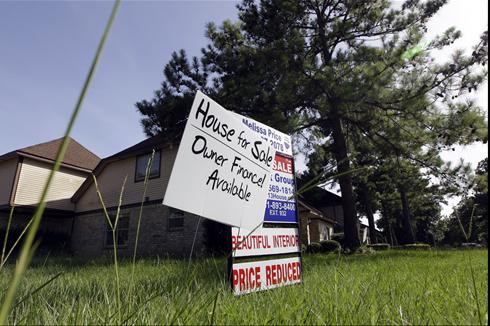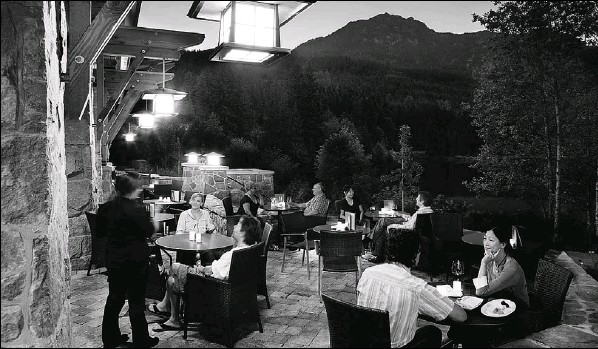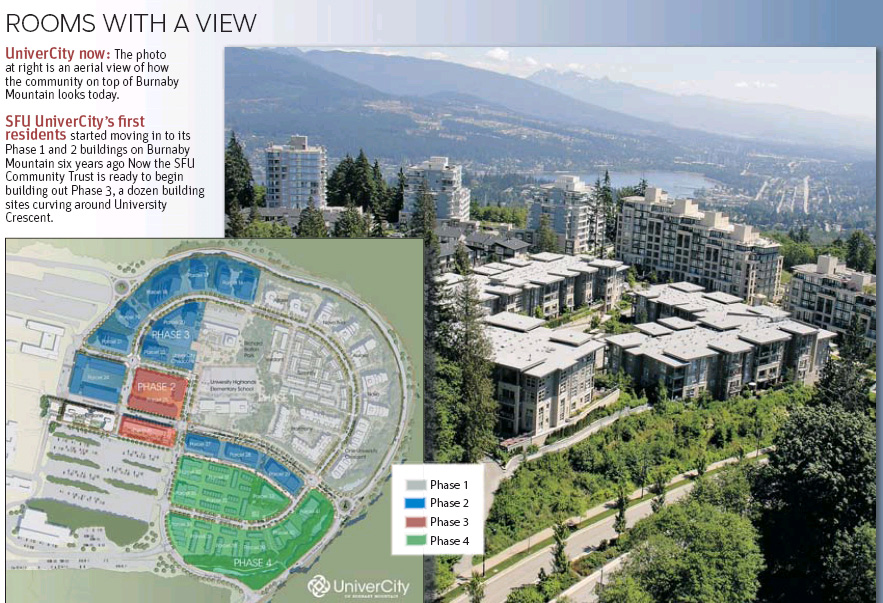Stephanie Armour
USA Today

An owner’s sign stands next to a real estate agent’s for sale sign noting a reduced home price in Houston recently. By David J. Phillip, AP
Emily Rennie’s three-bedroom house in Oakland was a beauty in a sweet location. Walking distance to the lakeshore. Close to shops. A refurbished patio in the back. Inside, a modern kitchen with granite countertops.
Listed at $539,000 when she put it on the market, the Excelsior Avenue house was missing one crucial thing: The right price. After a few weeks with no offers, she cut the price to $499,000 in May. Then she cut it to $475,000 in June. She is still hoping for an offer.
Rennie is discovering the cold reality of post-housing-bust prices: No matter what she thinks her house is worth, what matters is what buyers are willing to pay. That can be a lot less in areas where the supply of houses for sale is swollen by foreclosures and short sales, often priced 20% to 30% below the ones being sold by financially healthy owners. Nationally, such properties account for a third of all sales three years after a historic chill blew over an overheated housing market.
Foreclosures “do make it harder to sell,” acknowledges Rennie, who works in marketing communications. “People can get a really good deal.”
Real estate professionals say Rennie is in good company. Nationally, 30% of the houses for sale were reduced in price in June, according to Zillow.com, an online real estate site. Plenty of sellers have trouble pricing their home against the foreclosed houses that lenders are trying to unload.
“It’s one of the hardest things for sellers to do. They have an emotional attachment to their house,” says Amy Bohutinsky, a spokeswoman for Zillow.com. “For sellers to understand how they should price, they should deeply understand their market and competition — what’s on the market now, not just what’s sold.”
Those who do that successfully don’t have a problem.
“People who price their homes to the market are selling them in a reasonable amount of time, but people who cling to 2004 or 2005 prices aren’t,” says Richard Smith, president and CEO of Realogy, the parent company of Century 21, ERA, Coldwell Banker and Sotheby‘s International Realty. “If you take into account (bank-owned property) pressures, you’ll sell pretty quickly.”
Competition for bargains
Oakland and nearby San Francisco are two markets where foreclosures have a strong influence
Nearly three of every 1,000 homeowners in Oakland lost their homes to foreclosure in May, according to Zillow. Foreclosure resales made up 36% of all sales in May, although that’s down from a peak of 66% in March 2009.
Sellers have had to adjust. In June, 20% of the properties for sale in Oakland made price cuts, according to Zillow.com, compared with 15% in May. Drawn by falling prices, young professionals from San Francisco are coming across the bay to snap up homes in Oakland, and most of the stiffest competition for properties is in the top tier, around $808,000.
At that price, sellers in May paid 0.1% less than the asking price, according to Zillow. In all price ranges, they paid 0.3% less than asking price. Based on the median list price, that’s $1,080 less than the last listing price.
But some agents are seeing bidding wars.
“We’re seeing multiple offers; we’re seeing above asking price,” says David Kerr, a ZipRealty agent who represents buyers and sellers in Oakland. “People are buying foreclosures, fixing them up and selling them and getting offers.”
Those who do take foreclosures into account and price their homes right cannot only find a buyer, but sometimes one who will pay well above what they’re asking.
One such buyer was Rosa Verdin, 40, who bought a restored Victorian in north Oakland from a developer in May. The asking price was $450,000, which was well-priced, she says. She and her partner, Kelly Helms, 32, a nurse, offered $50,000 more, outbidding at least two other parties.
“We had been looking for six to eight months,” says Verdin, 40, who works in graphic arts. “The location was centrally located to our work, the house was move-in ready and within our price points. Timing just seemed right, and the decision was relatively easy.”
Not all offers go so smoothly. Even when owners find willing buyers, getting their price isn’t a sure thing. Lenders generally require appraisals before giving a mortgage, and appraisers often take into account what foreclosed properties in the area sell for when determining how much a home is worth. If a home is being sold at too high a price, the sale can fall apart.
“Every day, sales fall apart,” says Leslie Sellers, with the Appraisal Institute. “Smart sellers get appraisals done before they sell the home.”
Even in markets where most sellers are getting just below asking price, some are taking a long time to find a buyer. Glen Cox put his sprawling, five-bedroom Oaklandhome with sweeping views of the bay and Golden Gate bridge up for sale at the end of 2008 for $1.8 million. He’s selling it without a real estate agent. He took it off the market for a while after he got no offers. Today, he’s offering it for $1.695 million.
The house features vaulted ceilings, nine rooms with French doors, travertine balconies and an oak-arbored entry corridor. “There’re not many homes in the $1.5 (million) to $1.6 million range, and mine is nicer than most of them,” Cox says. “If you don’t have the one buyer right away, it can take awhile. It’s a very tough market.”
Neighborhoods buck trend
Other neighborhoods also show just how well good prices pull in successful offers.
In the heart of San Francisco, Noe Valley is home to dot-com millionaires and working professionals. The streets are lined with Edwardian and grand Victorian row houses built in the late 19th century, and the neighborhood, flanked by hills, features an eclectic array of coffee shops, sushi restaurants and lively bookshops.
The real estate market in San Francisco is struggling to regain its footing, with home prices down 0.7% from the third quarter of 2009 to the first quarter of this year. But in Noe Valley, most homes are going just above listing price. In May, homes sold for an average of 0.02% more than the last listing price, according to Zillow.com. Based on median list price, that translates into $218 more.
“It’s crazy,” says Brendon DeSimone, a Realtor with Paragon Real Estate in San Francisco, who represents buyers and sellers in Noe Valley. “I had one house with five offers, and it went from $1.4 million to $1.7 million. The valley has just popped. It’s not uncommon for one open house to have 200 people come through.”
Nationally, the average property takes eight to nine weeks to sell, down from 10 to 11 weeks a year ago, according to the National Association of Realtors. In Noe Valley in May, there were 25 listings that sold after averaging five weeks on the market.
But Paul McCickard, who put his home on the market in mid-March, is still waiting for a buyer. So far, he’s had only one offer. His home, priced at $2.149 million, is a 3,400-square-foot Edwardian with four bedrooms, a two-car garage, marble fireplaces, stream showers and a view of the skyline. He says he had to price it at that amount in part because it was an investment property. He bought in 2005, demolished the home and rebuilt it; he needs to pay back the money he owes on the construction — and hopes to make a little profit.
“We’ve invested a lot of money into the house, so it’s a matter of trying to recoup the money. Hopefully, it will sell,” says McCickard, who sells heavy equipment. “There’s been a lot of walk-throughs and a few interested parties, but we’re still waiting.”
Other homes have found buyers, and fast. Charlie Frisbie lost out on his first offer in Noe Valley, so he bid again last year on a two-bedroom Edwardian with an asking price of $998,000. There were a total of 11 offers; he got it at $1.1 million.
“You’re getting the best the city has to offer — transportation, good weather, access to parks,” says Frisbie, 48, an accountant. “Twice this year, homes came for sale on my block, but they didn’t even go on the market — they just sold. Those that do go on the market go substantially over” asking price.
Noe Valley has taken a hit as the overall housing market has tumbled, with home values down 17% from their peak in June 2008, according to Zillow.com. In the neighborhood, about 5% of home sales in March were foreclosure resales.
But Noe Valley remains a hot neighborhood for several reasons. Other neighborhoods such as Pacific Heights and the Marina District have already been in such demand that prices are often out of reach for younger families, DeSimone says. Noe Valley remains more affordable but still has the kind of row houses desired by families.
It’s also closer to Silicon Valley than other neighborhoods in northern San Francisco, which shaves off about 20 to 30 minutes of commuting time (Google and Apple both have bus stops in Noe Valley). And many buyers want historic Victorians, so demand for homes in the neighborhood is strong.
That’s why, when homes are priced well, they can set off a bidding frenzy — even in an anemic real estate market.






